
William Brown Street
Laurence Westgaph looks into the history of William Brown Street and reveals it's connections with the international slave trade.

Liverpool's Central Library and World Museum have their origins in wealth accrued through slavery. Originally named in honour of William Brown, who paid for the construction of the Free Public Library and Museum building, which he presented to the Lord Mayor of Liverpool on 18 October 1860. Brown was one of the premier importers of slave-produced cotton into Liverpool during the first half of the nineteenth century. The Browns were also the owners of many enslaved people on their plantations in the Deep South.

Sir William Brown, 1857, John Watson
Born in Ballymena, Ireland, in 1784, Brown and his family travelled to Baltimore in the United States in 1800, where his father established the firm of Alexander Brown & Sons, linen merchants. Tasked with setting up a Liverpool branch of the firm, William arrived from Baltimore in 1810 and quickly set up a business in the booming town. After the end of the Napoleonic Wars the company would grow exponentially through the buying and selling of slave produced cotton. According to the company’s historian, Aytoun Ellis, ‘It was not unusual for Alexander Brown & Sons to deal in as many as 30,000 bales of cotton in one transaction, and soon the Browns were handling 75 per cent or more of the American cotton, these huge shipments to Liverpool being William’s responsibility.’

Portrait of Sir William Brown, three-quarter length, seated to right, wearing a coat, jacket and cravat tied in a bow; within an oval. 1858 Lithograph on chine collé © The Trustees of the British Museum
By 1825 the massive growth of the business left William needing to find someone familiar with the American market to assist him and Joseph Shipley was taken on as a partner. The firm would continue to grow after his appointment and in 1838 the company sold 178,000 bales, equivalent to 15.8 percent of all U.S. cotton imports into the country for that year. The Liverpool house also took consignments of tobacco and other goods, but cotton was the main focus and by 1844 Brown held one-sixth of the trade between Great Britain and the United States. According to Richard Cobden, ‘There is hardly a wind that blows, or a tide that flows in the Mersey, that does not bring a ship freighted with cotton or some other costly commodity for Mr Brown's house.’
During the 1850s the company began to focus primarily on financing shipping firms bringing goods to Britain, selling the last of their plantations in the United States by 1860, just a year before the outbreak of the American Civil War that would lead to the abolition of slavery in the States. The war caused considerable conflict between William and his brothers although they no longer owned plantations directly. The New York office stood firmly with the Union during the war whilst their agencies in Baltimore, Savannah, Mobile, New Orleans and partners in Liverpool had ‘strong southern sympathies’.

View of the front of Liverpool's Central Library, with columns outside the main entrance; a cart in the foreground pulled by horses, the half-bust portrait of William Brown at top.Wood-engraving © The Trustees of the British Museum
In 1856, William agreed to pay the full cost of erecting an edifice to house Liverpool’s free library and museum, and on 15 April 1857 he would have the honour of laying the foundation stone. In gratitude to Brown for donating the monies for the completion of the library and museum, Shaw's Brow, the thoroughfare on which they were erected, was renamed William Brown Street. The building officially opened on 18 October 1860. Joseph Shipley, who had retired back to his native Delaware in 1850, bequeathed £1000 for the purchasing of books ‘as an old resident of Liverpool’ who wanted to show some appreciation to the people of the city where he had made his fortune. It was with Shipley’s donation that the library’s copy of Audubon’s ‘Birds of America' was acquired for the princely sum of £168 during the same year the library opened. Today there are only 119 complete copies of the book known to survive and it is one of the most valuable books in existence, with the record price achieved for a copy being $11.5 million, thought to be the 7th highest amount ever paid for a publication at auction.
William Brown served as M.P. for South Lancashire from 1846-1859 and was made a baronet in 1863. He died 3 March 1864, and is buried in St James Cemetery.

Brown's family vault in St James's Gardens By Phil Nash from Wikimedia Commons CC BY-SA 4.0 & GFDL
William Brown’s company evolved into a merchant bank that survives to this day as Brown Shipley & Co Ltd (trading as Brown Shipley BCSo), with headquarters in London. The American branch of the business also continues to trade as Brown Brothers, Harriman & Co, one of the largest private banks in the U.S.A. and possibly the oldest. Alexander Brown and Sons, considered one of the oldest investment banks in the U.S. is now part of Deutsche Bank.
Back to Liverpoolslaveryhistories.co.uk
